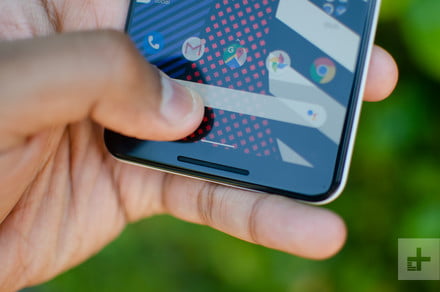Julian Chokkattu/Digital Trends
Since Google introduced a gesture navigation system in Android 9 Pie last year, various Android smartphone manufacturers have taken liberties opting for their own navigation systems, fragmenting the experience across the board. For Samsung’s Galaxy S10 phones, it’s a swipe up from the bottom left, middle, and right to use the back, home, and recents buttons, respectively. For OnePlus, a swipe up from the bottom left or right side of the screen will take you back, and a swipe up from the middle will go home. It can be confusing.
Android Q has revamped the gesture navigation system, mimicking Apple’s approach on its latest iPhones. There’s an elongated bar at the bottom of the screen, and you swipe up on it to go home. You can swipe left and right on the bar to quickly switch to the previous app, and swipe up and hold to open Recent apps. To go back, you swipe in from the left or right edge of the screen. It’s a much better implementation than the one in Android Pie, though it still feels a little rough around the edges.
But there’s another significant change happening with gestures in Android Q. Google has worked with its partners — the likes of Huawei, Samsung, LG, and other Android phone makers — to ensure a unified experience for new phones running Android Q. There will be two options to choose from: The revamped gesture navigation system as well as the traditional three-button setup Android has long used.
“If everyone does their own thing, Android apps are going to get worse.”
Google’s Allen Huang, product manager for the Android System User Interface, told Digital Trends the real motivator was to unify the navigation experience for the benefit of app developers, who need to consider individual phone navigation systems when designing apps.
“If everyone does their own thing, Android apps are going to get worse,” Huang said. “We went out to a bunch of our biggest developers and just talked them through that and shared that back with partners.”
So what happens with Android manufacturers that already have their own gesture navigation system? If you get the Android Q update on an existing phone, you won’t see any changes to your default navigation, because Huang said it’s not a good idea to disrupt the navigation experience for people. But if you buy a new phone that runs Android Q out of the box, your two main options will be the new Android Q gestures and the three-button system. They will be available on all new Android Q phones, period.
The likes of Samsung or OnePlus could add their own gesture navigation system in the phone’s settings — and you can swap to it after you’ve set the phone up — but they need to still offer the two main options as a way to standardize navigation across all phones.
“The different navigation systems have their pros and cons, but we’ve designed one that fits really well in the context of Android,” Huang said. “People use back many many times and making sure that’s super accessible was one of our primary goals.”
What about Google Assistant and navigating foldable phones?
Julian Chokkattu/Digital Trends
While Google is also working with manufacturers to encourage dedicated Google Assistant buttons, there still is a way to talk to Assistant from the gesture user interface. It’s available in the current Android Q beta, but it’s very janky. Going forward, it will become a diagonal swipe in from either one of the corners of the screen at the bottom to call up Google Assistant.
Huang also said the company didn’t entirely keep foldable phones in mind when designing the new gesture system, but it managed to work well on larger foldable screens since you can press the back button on either side of the screen. And there’s also a reason why they’re leaving the three-button navigation system in — because gestures aren’t very “accessible” for some people.
Offering two standardized options across all Android phones is a boon for the consumer. Manufacturers can still have their own variations, they just won’t be turned on by default.
Android Q will likely land around August, but we won’t see many new Android Q devices until around October. If you want to try out Android Q’s new gestures, you need a compatible phone, but the beta is available now as an over-the-air update.
Editors’ Recommendations
- Google I/O: Android Q will standardize navigation controls and add new gestures
- Android 10 Q hands-on review
- As Android’s nav bar fades, dedicated Google Assistant buttons are on the rise
- Android Q: Everything we know so far about Google’s next mobile OS
- How to download and install Google’s next-gen Android Q beta

